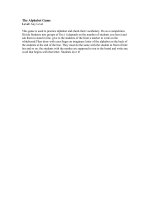The Implementation Game pot
Bạn đang xem bản rút gọn của tài liệu. Xem và tải ngay bản đầy đủ của tài liệu tại đây (3.8 MB, 428 trang )
The Implementation Game
This page intentionally left blank
The Implementation
Game
The TRIPS Agreement and the Global
Politics of Intellectual Property Reform
in Developing Countries
Carolyn Deere
1
3
Great Clarendon Street, Oxford ox2 6DP
Oxford University Press is a department of the University of Oxford.
It furthers the University’s objective of excellence in research, scholarship,
and education by publishing worldwide in
Oxford New York
Auckland Cape Town Dar es Salaam Hong Kong Karachi
Kuala Lumpur Madrid Melbourne Mexico City Nairobi
New Delhi Shanghai Taipei Toronto
With offices in
Argentina Austria Brazil Chile Czech Republic France Greece
Guatemala Hungary Italy Japan Poland Portugal Singapore
South Korea Switzerland Thailand Turkey Ukraine Vietnam
Oxford is a registered trade mark of Oxford University Press
in the UK and in certain other countries
Published in the United States
by Oxford University Press Inc., New York
© Carolyn Deere 2009
The moral rights of the author have been asserted
Database right Oxford University Press (maker)
First published 2009
All rights reserved. No part of this publication may be reproduced,
stored in a retrieval system, or transmitted, in any form or by any means,
without the prior permission in writing of Oxford University Press,
or as expressly permitted by law, or under terms agreed with the appropriate
reprographics rights organization. Enquiries concerning reproduction
outside the scope of the above should be sent to the Rights Department,
Oxford University Press, at the address above
You must not circulate this book in any other binding or cover
and you must impose the same condition on any acquirer
British Library Cataloguing in Publication Data
Data available
Library of Congress Cataloging in Publication Data
Deere, Carolyn.
The implementation game : the trips agreement, developing countries and the
global politics of intellectual property / Carolyn Deere.
p. cm.
Includes bibliographical references and index.
ISBN 978–0–19–955061–6
1. Agreement on Trade-Related Aspects of Intellectual Property Rights (1994)
2. Intellectual property (International law) 3. Foreign trade regulation.
I. Title.
K1401.A41994D44 2008
346.04’8–dc22 2008027666
Typeset by SPI Publisher Services, Pondicherry, India
Printed in Great Britain
on acid-free paper by
CPI Antony Rowe Ltd., Chippenham, Wiltshire
ISBN 978–0–19–955061–6
13579108642
To my family
Preface
This book is the product of both scholarly research and a decade of profes-
sional involvement in global policy debates on trade, intellectual property
(IP), and sustainable development. My goal has been to write a book that
captures what those closest to TRIPS implementation know first hand while
employing scholarly methods to help make sense of that experience. The out-
come is, I hope a book that both appeals to those working in the policy arena
and is compelling to scholars of international relations, political economy and
international law.
My interest in IP debates began as a Warren Weaver Fellow at the Rockefeller
Foundation in New York. At that time, Susan Sechler gave me the opportunity
to work with Anthony So, Peter Matlon, and Joan Shigekawa to build a grant-
making portfolio to promote a fairer course for international intellectual prop-
erty policy. A central part of that initiative was the Bellagio Series on Intellec-
tual Property and Sustainable and Development, which we launched in 2002.
In the subsequent years, the Bellagio Series brought together policymakers,
experts, diplomats, activists, and industry representatives with a variety of
different perspectives on global IP policy. I had the great privilege of attending
many of those meetings and this book draws extensively on conversations
with fellow participants. I left the Rockefeller Foundation convinced of the
need to bring greater transparency and accountability to global IP debates.
After discussion with colleagues and friends, I founded Intellectual Property
Watch, which is now the leading reporting service on international IP policy
debates. My research subsequently benefited greatly from its coverage of IP
news and from conversations with its Editor-in-Chief, William New.
This book also reflects personal experience of several hundred conferences,
policy dialogues, strategy meetings, and informal gatherings on IP policy in
developed and developing countries. During the course of this research, I also
attended several WTO ministerials and regularly observed WIPO meetings on
the WIPO Development Agenda and other issues. My analysis incorporates
personal observations of the political dynamics of these processes and the
players in them.
My research also benefited greatly from discussions with colleagues at
the International Centre for Trade and Sustainable Development (ICTSD) in
Geneva where I serve as a Resident Scholar. My role as Chair of the Board of
vi
Preface
3D → Trade–Human Rights–Equitable Economy, and participation in an inter-
national commisson (sponsored by the UK Royal Society of Arts) that drafted
the Adelphi Charter on Creativity, Innovation and Intellectual Property each
yielded useful opportunities to share ideas with experts at the cutting edge of
debates on intellectual property.
Among the many colleagues and friends whose ideas contributed to this
book, I am particularly grateful to Ahmed Abdel Latif, Alejandro Argumedo,
Leonardo de Athayde, Johannes Bernabe, Thiru Balasubramaniam, James
Boyle, Carlos Correa, Maria Carmen Dominguez, Vera Franz, Brewster Grace,
Chien Yen Goh, Rashid Kaukab, Soledad Leal, Faizel Ismail, Bernice Lee, Jamie
Love, Ricardo Meléndez-Ortiz, Catherine Monagle, Sisule Musungu, Maria
Julia Oliva, Davinia Ovett, Manon Ress, Pedro Roffe, Preeti Saran, Anthony
So, Christophe Spennemann, Matthew Stilwell, Geoff Tansey, David Vivas,
and Martin Watson. The analysis presented in this book also draws on over
150 interviews with individuals actively involved in global IP policy debates
and TRIPS implementation. Appendix 1 lists all interviewees except those
who requested anonymity. In the text, I only cite those who gave advance
permission.
This book builds upon work completed for my doctorate in 2006. The
development of my argument owed a great deal to discussions with my two
doctoral supervisors at the University of Oxford, Andrew Hurrell and Kalypso
Nicolaïdis, who provided wonderful advice, feedback, and support through-
out the three years. Together, their knowledge of international relations
scholarship served as a constant reminder that to study at Oxford is a great
privilege. I also thank the Ford Foundation, Oxford University Press and the
Universities UK Overseas Students Award Scheme for their financial support
and University College for granting me a Chellgren Scholarship.
At Oxford, I have the very good fortune to work with colleagues at the
Global Economic Governance Programme (GEG) and with its Director, Ngaire
Woods. In 2007, while working to complete this book, I launched the Global
Trade Governance Project at GEG, and was spurred on by the collegiality
of Mayur Patel and Arunabha Ghosh. In the course of my research, I also
benefited greatly from thought-provoking exchanges with Frederick Abbott,
Diana Barrowclough, James Boyle, Rashad Cassim, Carlos Correa, Jeremy de
Beer, Peter Drahos, Graham Dutfield, Peter Evans, Suzy Frankel, Richard Gold,
Robert Howse, Christopher May, Neil Netanel, Ruth Okediji, John Odell, Louis
Pauly, Susan Sell, Kenneth Shadlen, Richard Steinberg, Robert Wade, Robert
Wolfe, and Peter Yu, among others.
For reading various drafts of this book, I extend great thanks to Isalene
Bergamaschi, Alec Birkbeck, James Boyle, Caroline Dommen, Donna Green,
Zoe Goodman, Maria Ivanova, Kaitlin Mara, William New, John Odell, Ricardo
Meléndez-Ortiz, Catherine Monagle, Mayur Patel, Matthew Stilwell, Susan
Sell, Ruth Okediji, Pedro Roffe, Gina Vea, David Vivas, Ngaire Woods, and
vii
Preface
Caitlin Zaino. I am especially grateful to Ahmed Abdel Latif who read and
commented on the full manuscript. I also benefited tremendously from com-
ments provided by the examiners of my thesis and from an anonymous
reviewer for Oxford University Press. Nicholas Duston, Alicia Santos-Martin,
Pravir Palayathan, Priyanka Debnath, Tomas Felcman, Joshua Miller, Narae
Lee, Allison Tovey, and Eliot Pence all provided valuable research assistance.
Andrew Lowe served as valuable long-distance proofreader. At Oxford Univer-
sity Press, I also extend my thanks to Dominic Byatt, Lizzy Suffling, Louise
Sprake, and Aimée Wright for guiding this manuscript to completion. The
responsibility for any errors is of course mine.
Looking back, I thank Rolf Willmann for encouraging me to pursue a
doctorate, Ram Manikkalingam for interpreting my first musings back in New
York, and Sakiko Fukuda-Parr for spurring me to apply. Nancy Birdsall, Gordon
Conway, and Daniel Esty each kindly supported my application to Oxford.
The completion of this book would long since have faltered without the
encouragement of wonderful friends. In Oxford, I have been grateful for
the friendship of Arunabha Ghosh, Leondardo Martinez, Mayur Patel, Kate
Raworth, Kevin Watkins, and especially Ngaire Woods. From across the vast
oceans, I am lucky to have unfailing support from Donna Green, Catherine
Monagle, Maria Ivanova, Joanna Roche, and Allison Tovey. Closer to home,
I am deeply grateful to my friends in Geneva, especially Diana Barrow-
clough, Caroline Dommen, Erica Harper, Leslie Jones, Richardo Meléndez-
Ortiz, Matthew Stilwell, and Gina Vea. I owe a special debt to Ahmed, who
promised to show me the North African desert sky when my doctorate was
completed, and to Gina for sharing with me the place where the angels play.
Throughout the process of writing my doctorate and then completing this
book, my parents were amazing. My father was my long-distance technical
support team. My mother showed extraordinary patience and attention to
detail in helping with my bibliography (in the process becoming one of the
world’s few experts on Endnotes!). I cannot thank them enough.
Finally, I thank my amazing partner, Anthony Alexander, for his encourage-
ment, patience, and love as the hours I spent finishing this book turned into
months. This book is dedicated to Alec and to my parents.
February 2008
viii
Contents
List of Figure and Tables xi
List of Abbreviations xiii
1. The TRIPS Implementation Game: A Fight for Ideas 1
1.1. An Introduction to the Politics of IP and TRIPS 5
1.2. Variation in TRIPS Implementation 12
1.3. Existing Literature and Popular Narratives 14
1.4. Explaining Variation in TRIPS Implementation 17
1.5. Why This Book Matters 21
1.6. Methods and Sources 24
1.7. Scope 25
2. Developing Countries in the Global IP System 34
2.1. The Colonial Era: Variation and External Control 34
2.2. The Post-colonial Era: Reform and Resistance 37
2.3. The Counteroffensive for Stronger IP Protection 46
2.4. Implementation Amidst Contestation 56
3. Variation in TRIPS Implementation (1995–2007) 64
3.1. The TRIPS Outcome 64
3.2. Variation in the Timing of TRIPS Implementation 70
3.3. Variation in IP Standards and Use of TRIPS Flexibilities 74
3.4. A Typology of Variation 97
3.5. An Economic Explanation? 99
3.6. The Case for Political Analysis 104
4. Post-TRIPS Tensions and Global IP Debates 113
4.1. The Push for TRIPS-Plus 114
4.2. The Resurgence of Developing Country Confidence 118
4.3. Growing Complexity in the Global IP System 129
4.4. Expanding Teams of Players 133
4.5. Conclusion 142
5. International Pressures on Developing Countries 150
5.1. Economic Pressure 151
ix
Contents
5.2. Resistance and Retaliation 164
5.3. Ideational Power 167
5.4. Capacity building 180
5.5. Conclusion 186
6. The Developing Country Dimension: How National
Politics Mattered
196
6.1. Government Capacity on IP Decision-Making 197
6.2. Public Engagement 205
6.3. Government Coordination 211
6.4. Mini Studies of Variation 220
6.5. Conclusion 232
7. TRIPS Implementation in Francophone Africa 240
7.1. IP Reforms in the Poorest Countries: Expectations and Reality 243
7.2. From Colonization to the Revised Bangui Agreement 245
7.3. The Revised Bangui Agreement 252
7.4. The Bangui Revision Process 260
7.5. Capacity-building and Delegation in a Policymaking Vacuum 278
7.6. Conclusion 286
8. The Implementation Game and the Variation Puzzle 303
8.1. Global IP Politics 304
8.2. International Pressures 305
8.3. The National Dimension 309
8.4. Further Findings on Variation 315
8.5. Developing Countries in Evolving Global IP Debates 316
8.6. A Development-Oriented IP Agenda 320
Appendices
1. Selection of interviews
325
2. Timeline of international IP agreements 330
3. Examples of increase in IP standards in developing country
WTO members from 1988 to 2007
331
4. Variation in use of copyright flexibilities by selected
developing country WTO members in the Asia-Pacific
333
5. Examples of developing countries with bilateral agreements
that include IP provisions
335
6. Variation in TRIPS-plus provisions of selected U.S. FTAs 338
7. U.S. Special 301 pressure on developing country WTO
members and WTO disputes filed (1995–2007)
341
Bibliography 343
Index 396
x
List of Figure and Tables
Figure
3.1. Variation in IP protection among selected developing countries by
GDP per capita 100
Tables
2.1. U.S. trade action against key developing countries active in the GATT
negotiations (1985–93) 53
3.1. TRIPS transition periods 68
3.2. Examples of variation in timing of TRIPS legislative reforms 71
3.3. Examples of variation in choice of exhaustion regime for industrial property 76
3.4. Examples of variation in use of exclusions and exceptions to patent rights 79
3.5. Examples of variation in grounds for granting compulsory licences 83
3.6. Examples of variation in provisions on data protection for new
chemical entities in developing countries 85
3.7. Comparison of plant variety protection under UPOV and patent law 87
3.8. Examples of variation in approaches to plant variety protection 89
3.9. Examples of copyright limitations and exceptions available in TRIPS, Berne 90
3.10. Variation in copyright term among developing country WTO members 93
3.11. A typology of overall variation in IP standards 98
3.12. Comparison of approach to TRIPS implementation and GDP per
capita for selected developing country WTO members 101
4.1. Developing country TRIPS-related WTO submissions by country and
topic (1995–2007) 121
4.2. Developing country TRIPS-related WTO submissions by year and
topic (1995–2007) 124
5.1. Examples of TRIPS-plus provisions in bilateral trade agreements 152
5.2. Developing countries with TRIPS-plus terms of WTO accession 156
5.3. WTO TRIPS disputes involving developing countries 157
xi
List of Figure and Tables
7.1. Ministries responsible for industrial property in OAPI members 252
7.2. Comparison of the 1977 and 1999 Bangui Agreement 254
7.3. Examples of TRIPS-plus standards in the revised Bangui Agreement 256
7.4. Date OAPI members ratified the revised Bangui Agreement 257
7.5. Timing of WTO Trade Policy Reviews of OAPI members (1995–2007) 264
xii
List of Abbreviations
ACP African, Caribbean and Pacific Group of countries
ACT UP AIDS Coalition to Unleash Power
ACWL Advisory Centre on WTO Law
AGCC Arab Gulf Cooperation Council
AGI Association of Ghana Industries
AGILE Accelerating Growth, Investment, and Liberalization with Equity
AGOA Africa Growth and Opportunity Act
AIDS Acquired Immune Deficiency Syndrome
AIPPI Association internationale pour la protection de la propriété industrielle
ANCOM Andean Community of Nations
ANPII l’Association Nigérienne pour la promotion de l’invention et de
l’innovation
APPIA l’Association pour la promotion de la propriété intellectuelle en Afrique
ARCT African Regional Centre for Technology
ARIPO African Regional Intellectual Property Organization
ASEAN Association of South East Asian Nations
AU African Union
BIO Biotech Industries Organization
BIP Bilateral Intellectual Property Agreement
BIRPI United International Bureaux for Intellectual Property Protection
BIT Bilateral Investment Treaty
BSA Business Software Alliance
CAFTA Central American Free Trade Agreement
CBD Convention on Biological Diversity
CCTT Code of Conduct on the Transfer of Technology
CEEAC Economic Community of Central African States
CEMAC Central African Economic and Monetary Community
CFA Communauté Financière Africaine
CIEL Center for International Environmental Law
xiii
List of Abbreviations
CIPIH Commission on Intellectual Property Rights, Innovation and Public
Health
CIPR UK Commission on Intellectual Property Rights
CISAC International Confederation of Societies of Authors and Composers
CLEA Collection of Laws for Electronic Access
COM/AOC Conference of Ministers of Agriculture of West and Central Africa
COMESSA Community of Sahel-Saharan States
CPTech Consumer Project on Technology (now known as Knowledge Ecology
International (KEI))
DAI Development Alternatives, Inc
DFID Department for International Development (UK)
DHHS Department of Health and Human Services
DMCA Digital Millennium Copyright Act
DSU Dispute Settlement Understanding
ECAP European-ASEAN Intellectual Property Rights Cooperation Programme
ECOSOC United Nations Economic and Social Council
ECOWAS Economic Community of West African States
EFF Electronic Frontiers Foundation
EFPIA European Federation of Pharmaceutical Industries and Associations
EFTA European Free Trade Area
ENP European Neighbourhood Policy
EPA Economic Partnership Agreements
EPO European Patent Office
ETC Action Group on Erosion, Technology and Concentration
FAO UN Food and Agriculture Organization
FDI Foreign Direct Investment
FTA Free Trade Agreement
FTAA Free Trade Area of the Americas
G7 Group of Seven Industrialised Nations
G77 Group of 77
GATS General Agreement on Trade in Services
GATT General Agreement on Tariffs and Trade
GCC Gulf Cooperation Council
GDP Gross Domestic Product
GMO Genetically Modified Organism
GRAIN Genetic Resources Action International
GSK GlaxoSmithKline
xiv
List of Abbreviations
GSP Generalized System of Preferences
GTZ Gesellschaft für Technische Zusammenarbeit
HAI Health Action International
HIV Human immunodeficiency virus
IAC Industry Advisory Commission
ICAM l’Initiative Camerounaise pour l’accès aux médicaments
ICC International Chamber of Commerce
ICSIR India’s Council for Scientific and Industrial Research
ICTSD International Centre for Trade and Sustainable Development
IDA International Development Association
IDRC International Development Research Centre
IFAC Industry Functional Advisory Committee
IFPMA International Federation of Pharmaceutical Manufacturers Associations
IFPI International Federation of the Phonographic Industry
IGIP Inter-ministerial Group on IP
IIPI International Intellectual Property Institute
IISD International Institute for Sustainable Development
IMF International Monetary Fund
INDECOPI Peruvian Intellectual Property Office
INAO Institut national des appellations d’origine
INPI French Intellectual Property Office
IO International Organization
IP Intellectual Property
IPC Intellectual Property Committee
IPGRI International Plant Genetic Resources Institute
IPO Intellectual Property Office
IPP Intellectual Property Protection
IPR Intellectual Property Rights
ITPGRFA International Treaty on Plant Genetic Resources
ITU International Telecommunications Unions
JICA Japanese International Cooperation Agency
JIPO Jamaican Intellectual Property Office
KEI Knowledge Ecology International (formerly CPTech)
KIPO Korean Intellectual Property Office
KMA Kenya Medical Association
LAC Latin America and the Caribbean
LDC Least-Developed Country
xv
List of Abbreviations
MAI Multilateral Agreement on Investment
MERCOSUR Mercado Común del Sur
MFN Most-Favoured Nation
MNC Multinational Corporation
MOU Memorandum of Understanding
MSF Médecins Sans Frontières
NAFTA North American Free Trade Agreement
NEPAD New Partnership for Africa’s Development
NEPHAK Network for people living with HIV/AIDS in Kenya
NGO Non-governmental Organization
NIEO New International Economic Order
NMA National Medical Association
OAMPI Office Africain et Malgache de la propriété industrielle
OAPI Organisation Africaine de la propriété intellectuelle
OAS Organization of American States
OCAM Organization commun Africain et Malgache
OAU Organization of African Unity
OECD Organization for Economic Cooperation and Development
OHADA Organization for the Harmonization of Business Law in Africa
PACHA Presidential Advisory Council on HIV/AIDS
PCIPD Permanent Committee on IP and Development
PCT Patent Cooperation Treaty
PhRMA Pharmaceutical Researchers and Manufacturers of America
PIC prior informed consent
PMA Pharmaceutical Manufacturers Association
PSRP Poverty Reduction Strategy Papers
PVP Plant Variety Protection
QUNO Quaker United Nations Office
RAFI International Rural Advancement Foundation (now Action Group on
Erosion, Technology, and Concentration (ETC))
RAME Réseau Accès aux Médicaments Essentiels
SACU Southern African Customs Union
SAG Government of South Africa
SNL Structure Nationale de Liaison (National Liaison Structure)
SWAK Society for Women and AIDS in Kenya
TAC The Treatment Action Campaign
TAPWAK The Association of People living with AIDS in Kenya
xvi
List of Abbreviations
TK Traditional Knowledge
TIFA Trade and Investment Framework Agreement
TNC Transnational Corporation
TPA Trade Promotion Agreement
TPM technological protection measures
TPR Trade Policy Review
TRIPS Agreement on Trade-Related Aspects of Intellectual Property Rights
TWN Third World Network
UAM Union Africaine et Malgache
UCC Universal Copyright Convention
UNAIDS Joint United Nations Programme on HIV/AIDS
UNCTAD United Nations Conference on Trade and Development
UNDP United Nations Development Programme
UNECA United Nations Economic Commission for Africa
UNEP United Nations Environment Programme
UNESCO United Nations Educational, Scientific and Cultural Organization
UNICE Union of Industrial and Employers’ Federations of Europe
UNIDO United Nations Industrial Development Organization
UPOV International Union for the Protection of New Varieties of Plants
USAID U.S. Agency for International Development (now USTDA)
USITC U.S. International Trade Commission
USPTO U.S. Patent and Trademark Office
USTDA U.S. Trade and Development Agency
USTR U.S. Trade Representative
WAEMU West African Economic and Monetary Union
WCO World Customs Organization
WCT WIPO Copyright Treaty
WEF World Economic Forum
WGTT Working Group on Technology Transfer
WHA World Health Assembly
WHO World Health Organization
WIPO World Intellectual Property Organization
WOFAK Women Fighting AIDS in Kenya
WPPT WIPO Performances and Phonograms Treaty
WTO World Trade Organization
xvii
This page intentionally left blank
1
The TRIPS Implementation Game:
A Fight for Ideas
The World Trade Organization (WTO) Agreement on Trade-Related Aspects of
Intellectual Property Rights (TRIPS) is the centrepiece of the global system
of rules, institutions, and practices governing the ownership and flow of
knowledge, technology, and other intellectual assets. TRIPS emerged from the
Uruguay Round of the General Agreement on Tariffs and Trade (GATT) negoti-
ations (1986–94), and was a victory for multinational companies determined
to raise international intellectual property (IP) standards and boost IP protec-
tion in developing countries. During the TRIPS negotiations, industry lobby-
ists persuaded the world’s economic powers to wage a protracted campaign
against developing countries opposited to the deal. Developing countries
protested that the Agreement would consolidate corporate monopolies over
the ownership of ideas, exacerbate the north-south technology gap, and per-
versely speed the transfer of capital from developing to developed countries.
1
They argued that stronger IP standards would harm their development
prospects
2
and that they were ill-equipped to harness any purported benefits.
3
The conclusion of TRIPS represents a revolution in the history of IP pro-
tection. By establishing a universal, comprehensive, and legally binding set
of substantive, minimum IP standards, TRIPS both strengthens and supple-
ments the earlier patchwork, of international IP agreements.
4
To meet these
standards, TRIPS calls on all of the WTO’s 152 members
5
to take action
within their borders.
6
This requirement is particularly onerous for developing
countries as TRIPS demands far higher standards of IP protection than most
would otherwise provide.
For developing countries, a second battle began after the TRIPS negotia-
tions ended. As developing countries struggled to complete extensive reforms
of IP laws, administration and enforcement, they faced mounting pressures
from developed countries, multinational corporations, and some interna-
tional organizations, to adopt even higher IP standards than TRIPS requires
and to abstain from using the flexibilities available in TRIPS.
1
The Implementation Game
Amidst growing debates on globalization and inequality, TRIPS became a
symbol of the vulnerability of developing countries to coercive pressures from
the most powerful developed countries and galvanized critics regarding the
influence of multinational corporations on global economic rules. While IP
advocates insisted that stronger IP protection could serve as a ‘power tool for
development’,
7
a host of prominent international economists, such as Jagdish
Bhagwati and Joseph Stiglitz, questioned the place of TRIPS in the WTO
system (and continue to do so).
8
TRIPS triggered an intense global debate
on the relationship between IP regulation and development. In 2008, the
chief economics commentator for the Financial Times described constraints
upon developing countries in the area of IP as ‘unconscionable’.
9
Cambridge
economist Ha-Joon Chang, among others, emphasized the costs to developing
countries of introducing ‘irrelevant or unsuitable laws’ that restrict access
to technologies and knowledge.
10
Developing countries argued that TRIPS
ignored the diversity of national needs and forced them to sacrifice the ‘policy
space’
11
that richer countries had harnessed in early stages of their growth.
Given the vocal concern expressed by developing countries during the
TRIPS negotiations and after it came into force, one would reasonably expect
them to have taken full advantage of the possibilities the Agreement provides
to tailor implementation in response to national economic and social priori-
ties. Careful examination of the empirical evidence from 1995 to 2007, how-
ever, reveals a more complex picture of how developing countries responded
to this room for manoeuvre. There was striking diversity in the approach
developing countries took to the implementation of TRIPS rights and obliga-
tions. Most notably, d eveloping countries took varying advantage of the legal
safeguards, options, and ambiguities in TRIPS, now commonly referred to as
the TRIPS ‘flexibilities’.
12
Further, a surprising number of developing country
WTO members implemented even higher IP standards than those required
by TRIPS. By contrast, some developing countries took advantage of a range
of TRIPS flexibilities, but their approaches varied according to the type of IP
(e.g. copyright or industrial property). Further, many developing countries
missed their deadlines for bringing their laws into conformity with TRIPS,
thus effectively claiming more flexibility than provided for in the Agreement.
Across the developing world, governments struggled to upgrade institutional
capacity and resources to effectively administer and enforce their IP laws.
Why did developing countries ‘draw the line’ differently when implement-
ing TRIPS? Why did so many developing countries, but curiously not all,
implement reforms that went beyond minimum TRIPS requirements? What
explains the apparent contradiction between what most developing countries
said about TRIPS and what many did in respect of its implementation?
This book advances the first scholarly effort to explain the variation in
TRIPS implementation across the full spectrum of the WTO’s developing
country members, almost a third of which are least developed countries
2
The TRIPS Implementation Game: A Fight for Ideas
(LDCs).
13
In so doing, I build on a fragmented but growing literature on
the politics of global IP regulation and national IP reforms as well as the
work of scholars of international political economy and compliance with
international law. To date, the literature on TRIPS implementation has mostly
provided legal description and analysis. Where political analyses exist, they
usually focus on explaining TRIPS-‘plus’ reforms in selected developing coun-
tries. This book shares an interest in why IP laws in so many developing coun-
tries exceed TRIPS requirements, but its purpose is broader: that is, to explain
why we see such variation across the WTO’s developing country membership
in how governments approached TRIPS implementation from 1995 until the
end of 2007.
The reasons for variation in TRIPS implementation defy any one parsimo-
nions explanation. In this book, I provide an account that is richer, more
comprehensive, and more subtle than popular narratives about the reasons for
TRIPS-plus outcomes. The first challenge is to unpack the range of actors and
dynamics involved, and examine how their interplay contributed to variation
in TRIPS implementation. The second is to balance a search for general con-
clusions with a recognition of the complexity of global IP politics, the broad
scope of TRIPS, and the diversity of the group of countries under examination.
This book advances the metaphor of TRIPS implementation as a complex
political game. Developed and developing country governments were the
key players, flanked by teams comprising a range of stakeholders, including
multinational corporations, non-governmental organizations (NGOs), inter-
national organizations (IOs), industry lobby groups, and academics. Within
governments, a range of agencies were active. Trade officials and the staff
of national IP offices played particularly critical roles. Each of the players
devised strategic moves, appealed to both spectators and referees to influence
ideas about ‘fair play’, advanced different interpretations of the rules, and
tried to get away with whatever they could. This in turn demanded a mix of
psychology, rhetoric, strategy, technical skill, power, and endurance.
The TRIPS implementation game was intensely played because the eco-
nomic and social stakes were high and the playing field was deeply unequal.
The final TRIPS deal left both proponents and detractors dissatisfied, pro-
voking post-agreement efforts from both sides to revise the contested text,
sway its interpretation, and influence how it was implemented. The impacts
of strengthened IP protection were hotly debated. Further, across the period
under study, IP interests evolved and diversified in both developed and devel-
oping countries. A dynamic interaction ensued between debates regarding
possible revisions to TRIPS and the implementation of the Agreement at the
national level.
At the centre of these debates were different interpretations of what consti-
tutes legal, TRIPS-consistent behaviour. Like most of the negotiated outcomes
embodied in international laws, TRIPS contains many ambiguities and a
3
The Implementation Game
variety of inbuilt options. Further, the negotiating histor y of many TRIPS
provisions is disputed. Laws and actions which some developing countries
deem consistent with TRIPS obligations, developed countries consider TRIPS-
‘minus’. Conversely, developing countries view some developed country inter-
pretations of what constitutes TRIPS-‘minimum’ behaviour as TRIPS-plus. As
developing countries took steps to implement TRIPS, their questions were
many: What would constitute adequate implementation? How much ‘wiggle
room’ could they legally exploit?
In this political context, explaining variation in TRIPS implementation
demands attention to: (a) the interplay between evolving global debates on
IP and national reforms to implement TRIPS; and (b) the interaction between
international pressures on developing countries and the political dynamics
within them. In the chapters that follow, I specify the key actors and trends
in global IP debates, highlight where the interplay between negotiation and
implementation was most intense, and identify which factors governed the
interaction between international and national political dynamics to generate
different kinds of variation in implementation. The evidence shows that
explanations differ according to the particular aspects of TRIPS under study
and whether the focus is on the use of particular flexibilities; the strength
of standards overall; or the timing of implementation, administration, or
enforcement. Several broad findings also emerge which I briefly foreshadow
here.
First, accounting for variation demands a nuanced consideration of the
international pressures on developing countries, one that delineates differ-
ent forms and sources of power. Pressures for stronger IP protection were a
ubiquitous part of the global political landscape for TRIPS implementation.
Economic pressures exerted by developed countries and industries had a
decisive impact on TRIPS implementation in some countries, but was not
exercised equally across them. Further, across the developing world, countries
faced more subtle forms of power. IP advocates made strategic use of ideas
and knowledge to shape perceptions and understandings of what kind of IP
reforms were appropriate, possible, and would garner economic and political
rewards. Their opponents also harnessed the power of ideas, mounting a coun-
tervailing campaign to persuade countries to use TRIPS flexibilities. Capacity
building was a key vehicle through which this ideational power struggle
played out and had a decisive impact on the decisions many countries took.
Second, economic circumstances and political dynamics at the national
level made a significant contribution to variation in TRIPS implementation.
The developing countries that took most advantage of TRIPS flexibilities were
those that drew on a broad range of ministries, stakeholders, and expertise,
and that devised a policy framework through which they approached TRIPS
implementation. The countries that had participated most in TRIPS nego-
tiations had the greatest technical expertise on the Agreement and made
4
The TRIPS Implementation Game: A Fight for Ideas
the most targeted efforts to use its flexibilities. In short, the politics within
developing countries made a difference to TRIPS implementation: there was
some room for agency and manoeuvre. Alongside the many instances where
TRIPS-plus pressures prevailed largely unchallenged, there were important
cases of resistance, some of which succeeded. Importantly, as economic and
social circumstances changed and the configuration of domestic interest
groups evolved, some countries perceived stronger IP protection to serve their
interests in particular sectors.
This chapter presents an overview of the book. It begins with an intro-
duction to historical debates on IP, the emergence of a developing country
voice on international IP regulation, and the rocky, political road to TRIPS.
It then introduces the Agreement and several core elements of variation in
developing country approaches to its implementation, emphasizing variation
in timing and in the use of TRIPS flexibilities. After a brief review of relevant
literature, I set out my analytical framework for explaining variation in TRIPS
implementation, and preview this book’s contribution to the international
relations literature and global IP policy debates. To conclude, I provide a note
on methods, sources, and several boundaries that delimit the scope of this
book.
1.1. An Introduction to the Politics of IP and TRIPS
1.1.1. A History of Contestation
Debates between developed and developing countries over TRIPS reflect ten-
sions that inhere in the provision of IP rights and which have accompanied
IP regulation since its inception. Laws on IP are one of the central means
through which governments manage the ownership, availability, and use of
ideas and technologies, and the distribution of the profits they generate. IP
laws have a bearing on a range of critical and sometimes competing areas
of public policy, from industrial and health policy to cultural, agricultural,
and education policy. They can impact international competitiveness; the
pace and focus of innovation; and affordable access to new technologies,
knowledge, and creative works.
The origins of formal IP protection date back to fifteenth-century Venice
when the first patents were issued and to the late seventeenth century when
England laid the foundations for the first copyright laws.
14
Since then, the
range of IP rights has expanded. Patents protect the underlying ideas used
for industrial products or processes. Copyrights protect forms of expression,
such as written materials and artistic works, whereas trademarks protect
names and symbols associated with particular products and services. Through
these and other IP rights (including geographical indications, plant breeders’
rights, and utility models), governments grant inventors or creators private
5
The Implementation Game
rights to use, transfer, or profit from their work for a specified period of time.
These rights enable IP holders to legally control (with certain conditions)
the circumstances under which others can use their ‘products of the mind’.
15
Once the term of protection ends, patented inventions and copyrighted
works fall into the public domain where they may be freely used without
permission or payment. (Trade secrets work differently: they enable owners
to preclude any outside access to particular ideas indefinitely.)
In the case of patents, government intervention to grant private rights
is conditional on the public disclosure of information about the invention
through the publication of a patent document. Governments generally fur-
ther balance private rights by including safeguards and exceptions in their IP
laws that enable them, under selected circumstances, to promote public policy
goals such as building local industry or boosting the availability and afford-
ability of new inventions, ideas, technologies, and knowledge. To achieve
these ends, many countries include provisions in their IP laws that, for exam-
ple, limit the scope of patentability, enable compulsory licensing, require local
use or ‘working’ of patents, or allow for ‘fair use’ of copyrighted materials. To
guard against the abuse of the monopoly privileges that arise from private IP
rights, governments may also complement IP laws with antitrust or competi-
tion laws.
16
In addition, in some countries, laws to promote the availability
of medicines, protect genetic resources, or stimulate local industrial capacity
operate in conjunction with IP laws.
In designing IP policies and laws, governments face several core recurring
questions: what kinds of intangible assets warrant IP protection? To what
degree should private rights be afforded to them? What is the right balance
between private rights and public benefits? To what extent should a govern-
ment extend private rights to foreigners? A core challenge for governments
is how best to achieve the appropriate balance between, on the one hand,
providing incentives for innovation and creativity and, on the other hand,
ensuring the availability of the inputs necessary for further innovation and
affordable public access to the products that emerge. To discern the right
balance, governments must adjudicate a range of arguments for or against
stronger IP protection from stakeholders working to advance particular private
interests or public goals.
In a historical review of the recurring themes of patent debates, two leading
legal scholars compile convincing evidence that ‘there is little, if anything,
that has been said for or against the patent system in the 20th century
that was not said equally well in the 19th’.
17
Within developed countries,
disputes between investors, the producers and inventors of IP, and consumers
(and also among different groups within them) have prompted significant
shifts in IP laws over time. The United States and Europe have, for example,
experienced several cycles of IP reform, adjusting the terms of IP protection
to their stage of economic development and to the changing preferences and
6









